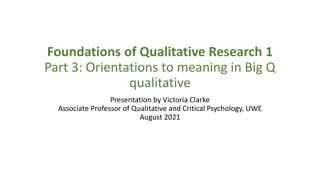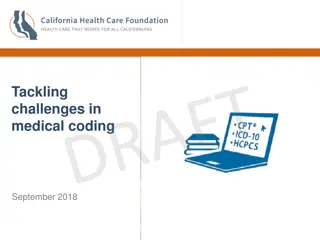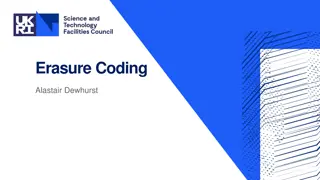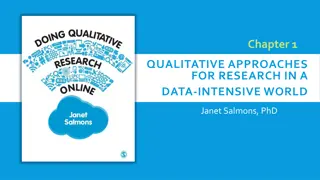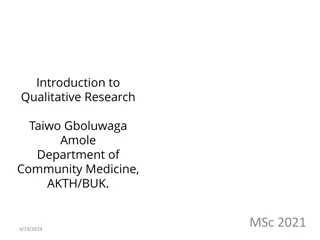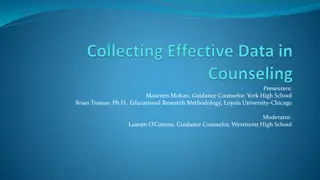Analyzing Qualitative Data: Steps and Coding Methods
Understanding qualitative data analysis involves several key steps, such as preparing the data through transcription, developing codes and categories using content analysis, revising categories based on the data, and reporting the analysis results. Content analysis helps in identifying words, themes, and concepts within texts objectively. Categorization can be done through a priori coding based on existing knowledge or through inductive coding by making sense of the text data. A sample coding scheme example illustrates how teachers interact with learners in a classroom setting to gather qualitative data.
Download Presentation

Please find below an Image/Link to download the presentation.
The content on the website is provided AS IS for your information and personal use only. It may not be sold, licensed, or shared on other websites without obtaining consent from the author. Download presentation by click this link. If you encounter any issues during the download, it is possible that the publisher has removed the file from their server.
E N D
Presentation Transcript
ANALYZING QUALITATIVE DATA
BASIC STEPS I. Prepare the data (Transcription) II. Develop codes / categories (content analysis) III. Complete and revise the system of categories based on the data IV. Report the result of data analysis
DevelopingCodes/Categories (Content Analysis) Content analysis is used to determine the presence of certain words, concepts, themes, phrases, characters, or sentences within texts or sets of texts and to quantify this presence in an objective manner. How can this be done? Making sense out of the text data Dividing the text into segments Labelling the segments with codes Examining codes (for overlap and redundancy) Putting them in broad themes
GettingReady toCode Mainly two ways of categorization: 1. A Priori Coding (Relational Analysis) : Before the analysis begins, the researcher determines the categories which are based on previous knowledge, experience, literature, or theory (i.e. Develops a coding scheme) These can be identified from a range of sources: Previous research or theory Research or evaluation questions you are addressing Questions and topics from your interview schedule PS. Conduct a pre-test to the coding scheme to see if it is working.
A SampleCodingScheme IRL IS Teacher starts a learning episode by asking questions relevant to the learning process Teacher starts a learning episode by assigning a learner to answer a question or answer the next exercise. Not successful response by the learner. Successful response by the learner. Learners use L1 to answer a question or to say something in L1 irrelevant to learning. Teacher uses L1 to reaffirm learner s answers. Teacher uses L1 to explain/simplify instructions, questions or exercises. Teacher uses L1 to prompt/encourage learners to participate in the lesson. Teacher provides learners with descriptive feedback Teacher provides boys with descriptive feedback Teacher provides girls with descriptive feedback Teacher provides learners with evaluative feedback Teacher repeats the answer to confirm Teacher provides boys with evaluative feedback Teacher provides girls with evaluative feedback Teacher provides learners with explicit feedback Teacher provides boys with explicit feedback Teacher provides girls with explicit feedback Teacher provides learners with implicit feedback Teacher provides boys with implicit feedback Teacher provides girls with explicit feedback RNS RS CA CC CES CP FDE FDEB FDEG FEVL RAC FEVB FEVG FE FEB FEG FI FIB FIG
A samplequalitativedata (classroomobservation) T: I m going to give you some words now. Words we use in present perfect simple. What kind of words do we use? Katerina K: Since, ehh already. T: thank you. Rita? R: just, ever T: just, ever. Rafaella? R: yet, often T: Sasha? S: ever T: ever. Nichola? N: before. T: not really.
T: I m going to give you some words now. Words we use in present perfect simple. What kind of words do we use? Katerina K: Since, ehh already. T: thank you. Rita? R: just, ever T: just, ever. Rafaella? R: yet, often T: Sasha? S: ever T: ever. Nichola? N: before. T: not really.
A samplecodingforthescheme T: I m going to give you some words now. Words we use in present perfect simple. What kind of words do we use? Katerina [IS] Teacher starts a learning episode by assigning a learner to answer a question or answer the next exercise. K: Since, ehh already. [RS] Successful response by the learner. T: thank you. Rita? [RAC] R: just, ever [RS] Successful response by the learner. T: just, ever. Rafaella? [RAC] Teacher repeats the answer to confirm R: yet, often [RS] Successful response by the learner. T: Sasha? S: ever [RS] Successful response by the learner. T: ever. Nichola? [RAC] Teacher repeats the answer to confirm N: before. [RNS] Not successful response by the learner. T: not really. [FEVL] Teacher provides learners with evaluative feedback Teacher repeats the answer to confirm
A samplecodingforthescheme T: I m going to give you some words now. Words we use in present perfect simple. What kind of words do we use? Katerina [IS] K: Since, ehh already. [RS] T: thank you. Rita? [RAC] R: just, ever [RS] T: just, ever. Rafaella? [RAC] R: yet, often [RS] T: Sasha? S: ever [RS] T: ever. Nichola? [RAC] N: before. [RNS] T: not really. [FEVL]
2. Emergent Coding (Grounded Coding--Conceptual Analysis): Categories emerge as the analysis continues. Good categories are Exhaustive (all relevant content can be categorized) Mutually exclusive (data can be placed in only one category) Independent (assignment of data to one category does not affect the assignment of other data to a category)
Codingthe Material (Analyzingthe Data) If you are using a priori coding, analyze the data according to the codes you have already identified. If you are using grounded/emergent coding, there are some steps to follow
StepsforEmergentCoding (Creswell, 2012) 1. Get a sense of the whole: read the transcripts and take notes in the margins 2. Take one document (e.g. one interview); go through it and consider the underlying meaning. 3. Start coding the document: identify text segments (word/sentence/paragraph for a code) and assign a code word for the segment (In first coding, don t use lots of different codes; try to assign only a few you can separate them later)
4. Make a list of all code words. Group similar codes and check redundancies (reduce if necessary) 5. Check the data with this list (grouped and reduced) and check whether new codes emerge. Circle the quotes that support the codes 6. Reduce the list of codes to get 5 - 7 themes (categories).
Reliability & Validity The primary reason for content analysis is to collect objective information, so reliability is very important and it means the degree to which multiple coders yield identical results. In general there are two stages in determining coding reliability. Ensure that the classification system is understood and applied to each unit separately. Compare how multiple coders classify a sample of the same material. (80% of agreement is good enough)
Main Advantages of Content Analysis 1. Quantifies largely qualitative information 2. Adds qualitative richness to otherwise quantitative data 3. Helps researchers learn more about issues of interest.
Disadvantages of Content Analysis 1. Usually limited to recorded information 2. Might have validity problems Analysts can achieve acceptable agreements (reliability) but the true meanings of categories might still be a problem. 3. Be challenged as too subjective.
1. Decide which code sums up what is being told in each line (A Priori) List of Codes: breaking up getting pregnant lifestyle settling down uncertainty moving in together insecurity not wanting to move proposal 1. When I found out I was pregnant, I wasn t sure if I wanted to get married and he 2. wasn t the settling down kind. He was old enough to bring up a child but I knew he 3. wasn t ready to. He was in the Navy he liked the life and preferred going off with 4. his friends and that bothered me. At first I hoped something would happen so I 5. didn t have the baby and I wanted him to marry me cause he wanted to not 6. because I was pregnant. Anyway when the baby was born we broke up and I have 7. seen him a couple of times but he has phoned lots and says he will marry me. He 8. wanted me to marry him and go and live with him, but I didn t want to leave home. 9. He leaves the Navy in 6 months so I m getting the flat ready for him to move in. But 10.I still worry he ll go off with his friends and won t be able to give up the life.
Original coding for the first 3 lines(exercise 1) 1. When I found out I was pregnant, I wasn t sure if I wanted to get married and he (getting pregnant) 2. wasn t the settling down kind. He was old enough to bring up a child but I knew he (settling down) 3. wasn t ready to. He was in the Navy he liked the life and preferred going off with (lifestyle) 4. his friends and that bothered me. At first I hoped something would happen so I 5. didn t have the baby and I wanted him to marry me cause he wanted to not 6. because I was pregnant. Anyway when the baby was born we broke up and I have 7. seen him a couple of times but he has phoned lots and says he will marry me. He 8. wanted me to marry him and go and live with him, but I didn t want to leave home. 9. He leaves the Navy in 6 months so I m getting the flat ready for him to move in. But 10. I still worry he ll go off with his friends and won t be able to give up the life.
Original coding for all the lines(exercise 1) 1. When I found out I was pregnant, I wasn t sure if I wanted to get married and he (getting pregnant) 2. wasn t the settling down kind. He was old enough to bring up a child but I knew he (settling down) 3. wasn t ready to. He was in the Navy he liked the life and preferred going off with (lifestyle) 4. his friends and that bothered me. At first I hoped something would happen so I (uncertaintly) 5. didn t have the baby and I wanted him to marry me cause he wanted to not (insecurity) 6. because I was pregnant. Anyway when the baby was born we broke up and I have (breaking up) 7. seen him a couple of times but he has phoned lots and says he will marry me. He (proposal) 8. wanted me to marry him and go and live with him, but I didn t want to leave home. (not wanting to move) 9. He leaves the Navy in 6 months so I m getting the flat ready for him to move in. But (moving in together) 10. I still worry he ll go off with his friends and won t be able to give up the life. (insecurity)
2. Write a code that summarizes what happens in each line (Grounded) 1. It was challenging, after living in Italy for 6 months and then I moved home before 2. I started university. I was used to doing things my own way when it suited me 3. and not having to tell people where I was going. I was living with friends and they 4. didn t care what I did or where I went. It was really hard to go back to sort of 5. thinking of others cause Mum and Dad wanted to know where I was going and 6. who with, which was a nightmare. My parents were strict but I had a lot of 7. freedom growing up, as long as I didn t overstep the boundaries. After I came 8. back from Italy they realised I was more independent and things changed and 9. they didn t try and stop me doing things anymore but they would still let know if 10. they didn t approve.
Original Coding (exercise 2) 1. It was challenging, after living in Italy for 6 months and then I moved home before moving away 2. I started university. I was used to doing things my own way when it suited me independence 3. and not having to tell people where I was going. I was living with friends and they freedom 4. didn t care what I did or where I went. It was really hard to go back to sort of moving back home 5. thinking of others cause Mum and Dad wanted to know where I was going and control 6. who with, which was a nightmare. My parents were strict but I had a lot of control 7. freedom growing up, as long as I didn t overstep the boundaries. After I came boundaries 8. back from Italy they realised I was more independent and things changed and growing up 9. they didn t try and stop me doing things anymore but they would still let know if letting go 10. they didn t approve. disapproval
What themes (main categories) can you generate? 1. It was challenging, after living in Italy for 6 months and then I moved home before moving away 2. I started university. I was used to doing things my own way when it suited me independence 3. and not having to tell people where I was going. I was living with friends and they freedom 4. didn t care what I did or where I went. It was really hard to go back to sort of moving back home 5. thinking of others cause Mum and Dad wanted to know where I was going and control 6. who with, which was a nightmare. My parents were strict but I had a lot of control 7. freedom growing up, as long as I didn t overstep the boundaries. After I came boundaries 8. back from Italy they realised I was more independent and things changed and growing up 9. they didn t try and stop me doing things anymore but they would still let know if letting go 10. they didn t approve. disapproval
3. Code the following data and develop themes/categories We were playing for our title. (the injury) It was pretty bad I got a concussion and I hurt my jaw it was probably one of the worst concussions I have had so far This is my thirteenth year (of playing this sport). I m on a high school varsity team I also play on another like semi-competitive team everyone kind of just goes for the ball it wasn t really a foul or anything I don t really remember it people say it was like my own team mate that kicked me.(smiling) but I don t really blame her, she was just trying to stop the goal I was really frustrated
A Sample Coding (exercise 3) Raw data themes Higher order sub-themes (the injury) It was pretty bad I got a concussion and I hurt my jaw it was probably one of the worst concussions I have had so far This is my thirteenth year (of playing this sport). I m on a high school varsity team I also play on another like semicompetitive team experience of her injury experience of playing football feelings about the accident Everyone kind of just goes for the ball It wasn t really a foul or anything I don t really remember it people say it was like my own team mate that kicked me.(smiling) but I don t really blame her, she was just trying to stop the goal
4. Following transcripts are taken from an interview with 3 people. Read the responses of the interviewees and develop the common themes/categories that come up.
4. Interview Question: How would you assess the level of automation in your office? 21 Overall, the system is pretty good. The information we have access to is very helpful. But, updates to the data base are batch processed. If the system allowed real-time updates this would give case workers more up-to-date information. 22 The terminals hurt my eyes. They are hard to look at for long periods of time. The system is very slow retrieving information, and much of the information we get is miscoded or incorrect. Terminal time is also limited because of frequent down time for repairs. I can t say the current system helps me much in doing my job. 23 There is a serious lack of printers. Case workers need to be able to print out information on our terminals, but this is time consuming because we all have to send output to one printer. Lots of days the printer is offline for repairs which complicates the situation



